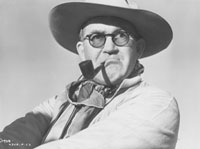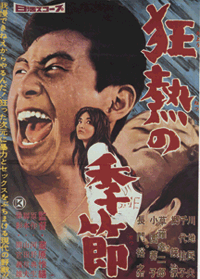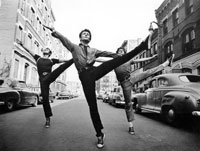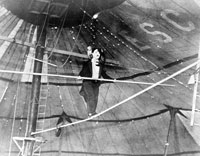Cinematheque begins semester of rarely seen films
In a culture that has people installing expensive home theaters to watch the latest Hollywood blockbuster in the basement of their suburban starter castle, UW–Madison’s Cinematheque might seem a sprocket or two off.

Restored prints of the films of John Ford, shown on a big screen, will dazzle audiences. The 14 films in the retrospective include the silent masterpiece “Four Sons,” “The Searchers,” “Stagecoach” and “How Green Was My Valley.”
At Cinematheque, people gather in 4070 Vilas Hall on Friday and Saturday nights to watch films that are rarely screened, such as silent films, early talkies, international cinema and gems that are not available on video or DVD. And this communal appreciation has been going on, at no charge, since spring 1998.
The Cinematheque was named for the famous Cinematheque Française in Paris, which functions as a combination library-museum by preserving and showing films.
That there is a cinematheque at UW–Madison says something about the appetite for film on campus and in the Madison community. “Most cinematheques are in big cities, connected to a museum or affiliated with a school on the coasts. People in Madison are dedicated to the movies. They are sophisticated viewers. We know they don’t have any problem with watching a black and white film or one with subtitles,” says Lea Jacobs, director of Cinematheque and professor in the Department of Communication Arts.

Nikkatsu Action Cinema is known for flashy stylistics, complicated narratives and a pantheon of male stars. These films flooded the Japanese market, peaking from the late 1950s to the early 1960s.
During its early years, Cinematheque organized occasional film series along with visiting filmmakers or guests. Over the years, offerings were expanded and the screening room was remodeled and two 35mm projectors were added.
The addition of a staff programmer was also a big help in growing an audience and expanding offerings. “I came here from Boston where I was a film programmer at the Goethe-Institut and we charged $6–$8 for a screening,” says Karin Kolb, current Cinematheque programmer. “It’s free here, and that’s a big deal. I don’t think people realize how great it is.”
Still, the Cinematheque keeps a steady eye on how its programming contributes to the scholastic mission on campus. “We serve nearly all of the College of Letters and Science as well as the community at large. The films expose students to art, music, languages, international studies and history — it all overlaps in films,” says Jacobs.

“West Side Story,” will be shown Friday, May 2. The screening pays tribute to UW–Madison alumnus and three-time Academy Award-winner Walter Mirisch.
Jacobs is teaching a course this semester on the films of John Ford and classical Hollywood cinema, and Cinematheque has a series of his films ready to supplement the in-class screenings (see sidebar). “Once you watch a Ford film in 35mm you’ll never want to go back to watching on the TV, which I do, but never without regret. So much care goes into every composition, and the color and luminosity are lost,” says Jacobs. “It’s like looking at a reproduction of the Last Supper. Sure, you can learn from it, but to really know it — it’s not the same image.”

The Charlie Chaplin silent classic “The Circus,” will be shown on Saturday, April 26, in cooperation with the Chazen Museum of Art and its exhibitions “Ringmaster: Judy Onofrio and the Art of the Circus,” and “Harry A. Atwell, Circus Photographer,” which are on view from April 19–June 29.
Selecting the films is an art form in itself. Suggestions from a committee and opportunities for collaboration with other campus units such as the Chazen Museum of Art or a language department are all part of the process. “We are always on the lookout for new restorations, prints or subtitles. We do our best to honor requests and be inclusive with campus and serve the university,” says programmer Heather Heckman, a Ph.D. student in film history.
Organizing a film series is an involved and complicated process and finding the films in the first place can be a bit of a scavenger hunt. Jacobs says it took two seasons to organize a recent Godard retrospective.
“There isn’t a database of films that we can order from and then just have them delivered,” says Kolb. “Budget cuts are also a problem. With a strong euro and rental fees, some are just too expensive for us. It can cost $500–$700 just for shipping fees for one European film.”
Despite those challenges, Cinematheque’s commitment to screening the best possible prints available is unflagging, and sometimes that commitment ensures access for others into the future. Case in point: A new print of “The Searchers” and a restoration of “Cita en la frontera” were made just for Cinematheque’s spring season.
“The films we show were the blockbusters of their time, nation or culture. It’s still great storytelling,” says Heckman. “And we show them for free. What’s the harm in trying something new?”
The Cinematheque’s spring season features nine exciting film series, special events and new and restored prints and films available for the first time in the United States.
All films take place at UW Cinematheque, 4070 Vilas Hall. Admission is free, but seating is limited. For more information, contact Heather Heckman, 262-3627, heckman@wisc.edu; or Karin Kolb, 262-3627.
This semester at Cinematheque:
Series
- Fort Hollywood: The Films of John Ford
Best known for his westerns, Ford made more than 125 feature films during his career. Known for stunning extreme long shots and gorgeous location shooting, Ford received four Academy Awards for best director, which is still the record. The 14 films in the retrospective cover 40 years of Ford’s work, including the silent masterpiece “Four Sons,” the iconic “The Searchers,” the action-packed “Stagecoach” and the sentimental “How Green Was My Valley,” which beat out “Citizen Kane” for best picture. The newly restored prints in this series will give Ford’s legendary film style the appreciation it deserves.
- Michael Haneke: A Cinema of Provocation
Haneke is known to American audiences for his recent French language films “Cac
,” “The Piano Teacher” and “Code Unknown.” However, he has been making films since the mid-1970s. Many have now been subtitled, giving American audiences the chance to view Haneke’s larger body of work for the first time. In these films, the theme of modern society’s descent into alienation and coldness is portrayed in his unique bleak and disturbing style. - No Borders, No Limits: Nikkatsu Action Cinema, 1960-64
Nikkatsu Action films flooded the Japanese market, peaking from the late 1950s to the early 1960s. These films reflected the Western influence on postwar Japanese culture, with cowboys, bebop jazz, big American cars and night clubs with hipsters. Nikkatsu Action cinema is known for flashy stylistics, complicated narratives and a pantheon of male stars.
- Third Annual LACIS Festival de Cine: Argentine Women Directors — Argentine Actresses
Each spring the Cinematheque collaborates with the Latin American, Caribbean and Iberian Studies Program (LACIS) to present a film series from a different region of the Spanish/Portuguese-speaking world. This year’s festival highlights Argentine women directors and actresses. The six films in the series feature debut works by renowned filmmakers Lucrecia Martel and María Luisa Bemberg, Argentina’s 2008 Oscar bid, and the classic 1940s tango musical, “Cita en la frontera,” starring legend Libertad Lamarque.
- Archival Treasures: Recent Columbia Restorations
Each spring, the Cinematheque presents new restorations by world-renowned preservation departments. This year, Columbia restorations by the Sony Film Archive are featured, with some of the best American films from the early 1930s and the 1950s. Grover Crisp, vice president of Asset Management and Film Restoration at Sony Pictures Entertainment, will present one of his recent restorations, “American Madness,” on May 9.
Special Events
- Wisconsin Film Festival Thursday, April 3-Sunday, April 6
The Cinematheque is one of many theaters on campus and in downtown Madison to host this four-day event, presented by the UW Arts Institute. The schedule will be announced Thursday, March 6; tickets go on sale Saturday, March 8. Information: 262-9009, http://www.wifilmfest.org.
- “The Circus,” Saturday, April 26
The beloved silent Charlie Chaplin classic from 1928 is shown in cooperation with the Chazen Museum of Art and its exhibitions “Ringmaster: Judy Onofrio and the Art of the Circus,” and “Harry A. Atwell, Circus Photographer” (April 19-June 29).
- “West Side Story,” Friday, May 2
If you haven’t seen Leonard Bernstein’s musical retelling of the “Romeo and Juliet” story in 1950s gangland New York on a big screen, you haven’t really seen it.
The screening pays tribute to UW–Madison alumnus and three-time Academy Award-winner Walter Mirisch. During his long and distinguished Hollywood career, Mirisch produced more than 50 films. His filmography is sprawling, including Academy Award-winning pictures such as “West Side Story,” “The Apartment” and “In the Heat of the Night.” Mirisch’s autobiography, “I Thought We Were Making Movies, Not History,” is due to be released in April by the University of Wisconsin Press. The book will be the latest addition to the series Wisconsin Film Studies, edited by another UW–Madison alumnus, notable film biographer Patrick McGilligan.
Other notables include
- “The Magnificent Seven,”
- the five-film “Pink Panther” series
- “The Thomas Crown Affair”
- “Invasion of the Body Snatchers,”
- “Seven Angry Men”
- “Some Like it Hot.”
Mirisch’s book, “I Thought We Were Making Movies, Not History,” is due to be released next month.
Visit Cinematheque for a complete schedule.
Tags: arts, College of Letters & Science, events, film




